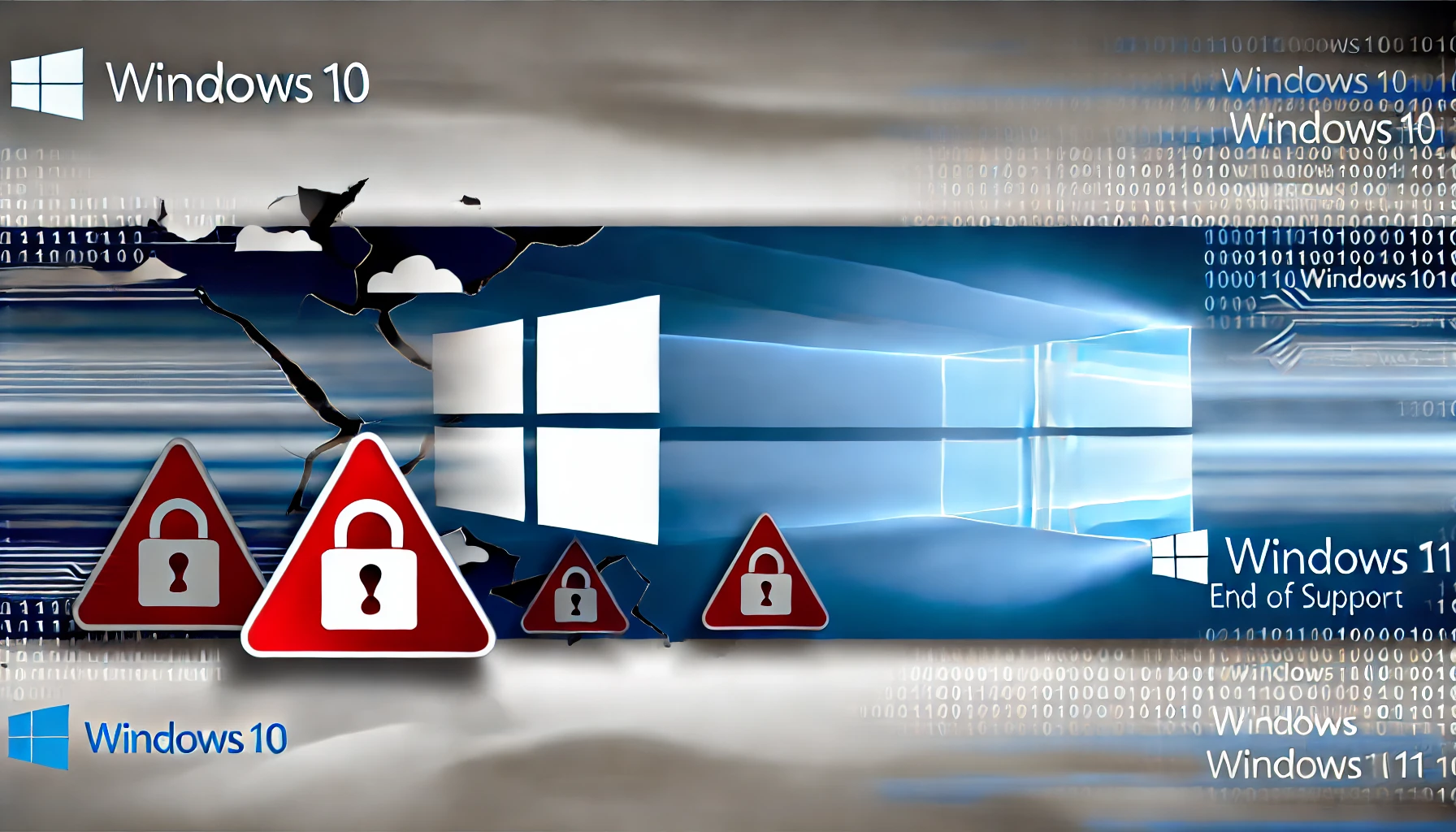Windows 10 End of Support: What It Means for Security and Unsupported Versions
In recent months, Microsoft has issued multiple warnings to its vast user base, particularly for those still running Windows 10. As we approach the end of support for this widely used operating system, millions of users must be aware of the security risks and vulnerabilities that could arise. In this blog, we’ll explore what the end of support means, the dangers of continuing to use unsupported versions, and the steps you can take to protect your data and systems. Additionally, we’ll dive into the Microsoft update warning issued to users and the significance of installing the latest vulnerability patches.
What Happens When Windows 10 Support Ends?
Windows 10 has been a reliable operating system for millions of users worldwide since its launch in 2015. However, as with all software, Microsoft has an established lifecycle for its operating systems. The official end of support for Windows 10 is set for October 14, 2025(Cyrixx Search). After this date, the system will no longer receive critical security updates or vulnerability patches, leaving users exposed to a variety of threats.
The end of support doesn’t mean that your system will suddenly stop working. However, it does mean that any new Windows security risks will no longer be addressed by Microsoft, making it increasingly dangerous to use the outdated software. In essence, any bugs or vulnerabilities that emerge after the end of support will remain unpatched, and cybercriminals are quick to exploit these unprotected systems.
Windows Unsupported Versions: A Growing Risk
Users still running unsupported versions of Windows, such as Windows XP, Vista, or Windows 7, are already experiencing the dangers of using outdated systems. These operating systems, which have long since passed their support deadlines, no longer receive security patches or technical support from Microsoft. As a result, they are significantly more vulnerable to viruses, malware, and other forms of cyberattacks.
The risk is particularly high for businesses and individuals still reliant on these outdated platforms. Cybercriminals often target these systems because they know the vulnerabilities will remain unpatched indefinitely. For those still running Windows unsupported versions, the safest course of action is to upgrade to a supported version, such as Windows 11, or at least Windows 10, before the support deadline arrives.
Microsoft Update Warning: Why You Need to Pay Attention
In light of these risks, Microsoft has issued several update warnings for users still on older versions of its operating systems(Windows Forum). The warnings highlight the necessity of upgrading to Windows 11 to stay protected from emerging Windows security risks. Recent Microsoft vulnerability patches aim to address key security holes that could allow cybercriminals to take control of unprotected systems.
Ignoring these update warnings not only jeopardizes your system’s security but also puts sensitive personal or business data at risk. Many of the vulnerabilities addressed in these patches can prevent devastating consequences, such as ransomware attacks, identity theft, or data breaches.
For example, Microsoft’s recent vulnerability patches for Windows 10 and Windows 11 addressed several severe vulnerabilities, including one that allowed attackers to execute malicious code remotely. Without the latest Microsoft security patches, users could unknowingly leave their systems open to these kinds of attacks.
Windows 11 Upgrade Issues: Why the Transition Can Be Challenging
While Windows 11 has been lauded for its improved security features, the transition to the new operating system has not been smooth for everyone. Many users have reported Windows 11 upgrade issues, including software incompatibilities, hardware requirements, and bugs(Microsoft Learn)(Cyrixx Search). One of the biggest hurdles is the system’s need for TPM 2.0 (Trusted Platform Module), which ensures better encryption and device security but is not compatible with older hardware.
For users experiencing these Windows 11 upgrade issues, it’s important to weigh the benefits of staying on Windows 10 versus the long-term security risks. Although the transition may present technical difficulties, it is crucial to ensure your system stays secure in the long run. If upgrading to Windows 11 isn’t feasible, consider at least staying updated with the latest Windows 10 security patches until support ends.
Windows 10 vs. Windows 11 Security: What’s the Difference?
As you decide whether to upgrade, understanding the Windows 10 vs. Windows 11 security differences is crucial. Windows 11 comes with several enhanced security features aimed at safeguarding against modern threats. These include:
- Secure Boot: This ensures that only trusted software is loaded during the boot process, preventing malware from starting up before the operating system.
- Virtualization-Based Security (VBS): VBS isolates critical system components from malware, making it harder for attackers to compromise sensitive information.
- Advanced Encryption: Windows 11 employs stronger encryption techniques, making it more difficult for cybercriminals to access your data.
In contrast, while Windows 10 remains relatively secure for now, it lacks many of the advanced security features built into Windows 11. As Windows 10 approaches its end of support, these security gaps will only widen, making an upgrade more critical for those who prioritize data protection.
Microsoft Vulnerability Patches: A Crucial Line of Defense
Installing the latest Microsoft vulnerability patches is your first line of defense against cyber threats. These patches address newly discovered vulnerabilities and often fix serious flaws that could lead to system compromises. Recently, Microsoft released patches addressing critical issues in Windows 10 and Windows 11, protecting millions of users from potential exploitation.
By regularly updating your system with these patches, you ensure that your computer is protected from the most recent threats. Many users overlook the importance of staying up-to-date, but a delayed or missed Microsoft security patch could be the weak link that allows a cyberattack to succeed.
Windows Update Problems: Troubleshooting Common Issues
One of the major concerns for users, especially those reluctant to upgrade, is the occurrence of Windows update problems. These can range from slow installation times and software crashes to failed updates altogether. However, many of these issues can be resolved with simple troubleshooting techniques.
- Check your internet connection: Slow or unstable internet can cause update downloads to fail or take longer than usual.
- Ensure sufficient storage space: Lack of disk space can cause updates to stall or fail.
- Disable third-party antivirus: Sometimes, third-party antivirus software can interfere with the update process. Temporarily disabling it may resolve the issue.
- Use the Windows Update Troubleshooter: Windows has a built-in tool designed to identify and resolve common update problems.
For users experiencing persistent Windows update problems, Microsoft’s online support provides detailed guides to troubleshoot and fix these issues(Microsoft Learn)(Windows Forum).
Staying Protected as Windows 10 End of Support Approaches
As Windows 10 end of support nears, the need for users to take action is urgent. Whether upgrading to Windows 11 or ensuring your current system has the latest Microsoft security patches, it’s essential to remain vigilant in protecting your data and devices. Ignoring these warnings and updates can leave you vulnerable to a wide range of Windows security risks and vulnerability patches that could be the difference between a secure system and a catastrophic cyberattack.
For more information on how to stay updated and secure during this transition, visit Regent Studies.
In conclusion, whether you’re struggling with Windows 11 upgrade issues or experiencing Windows update problems, staying informed and proactive is the key to keeping your systems secure as we move forward into a post-Windows 10 era.




